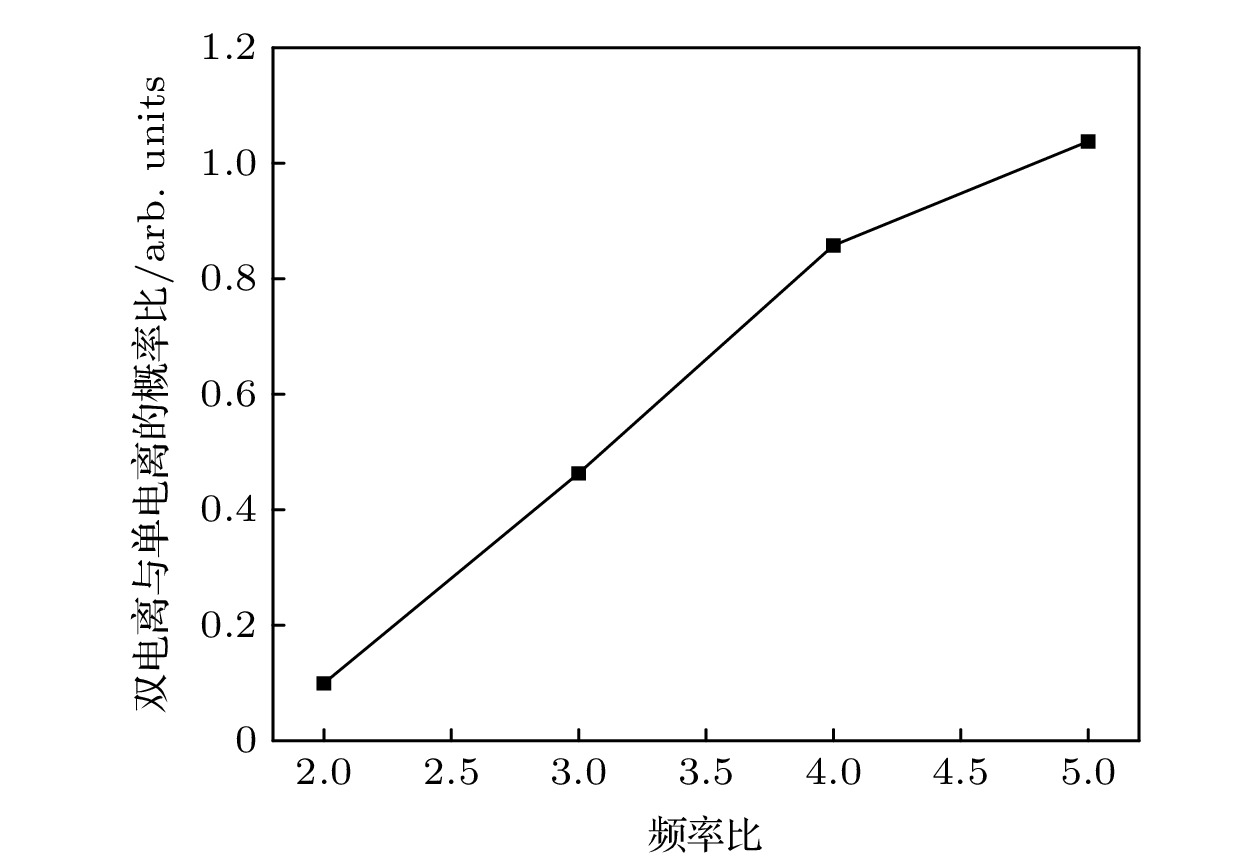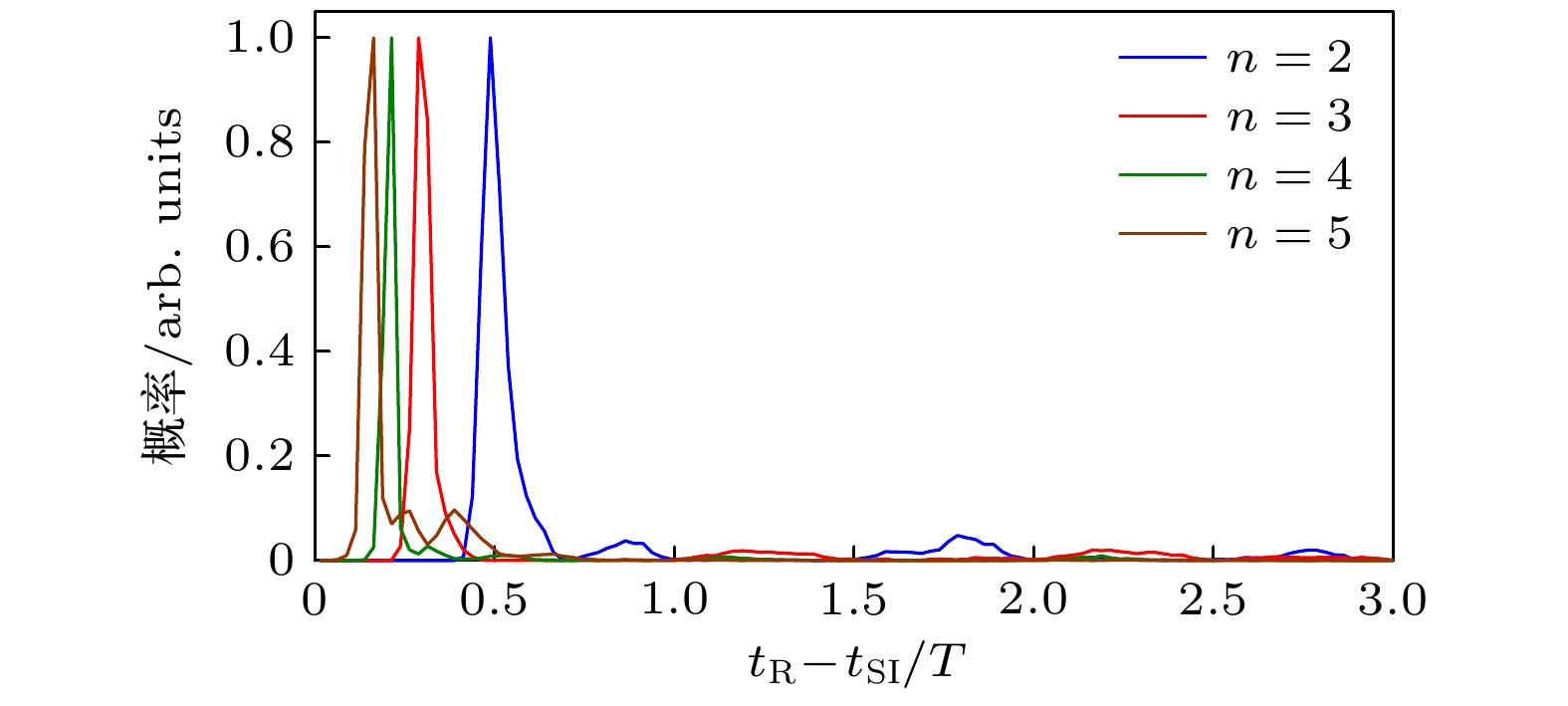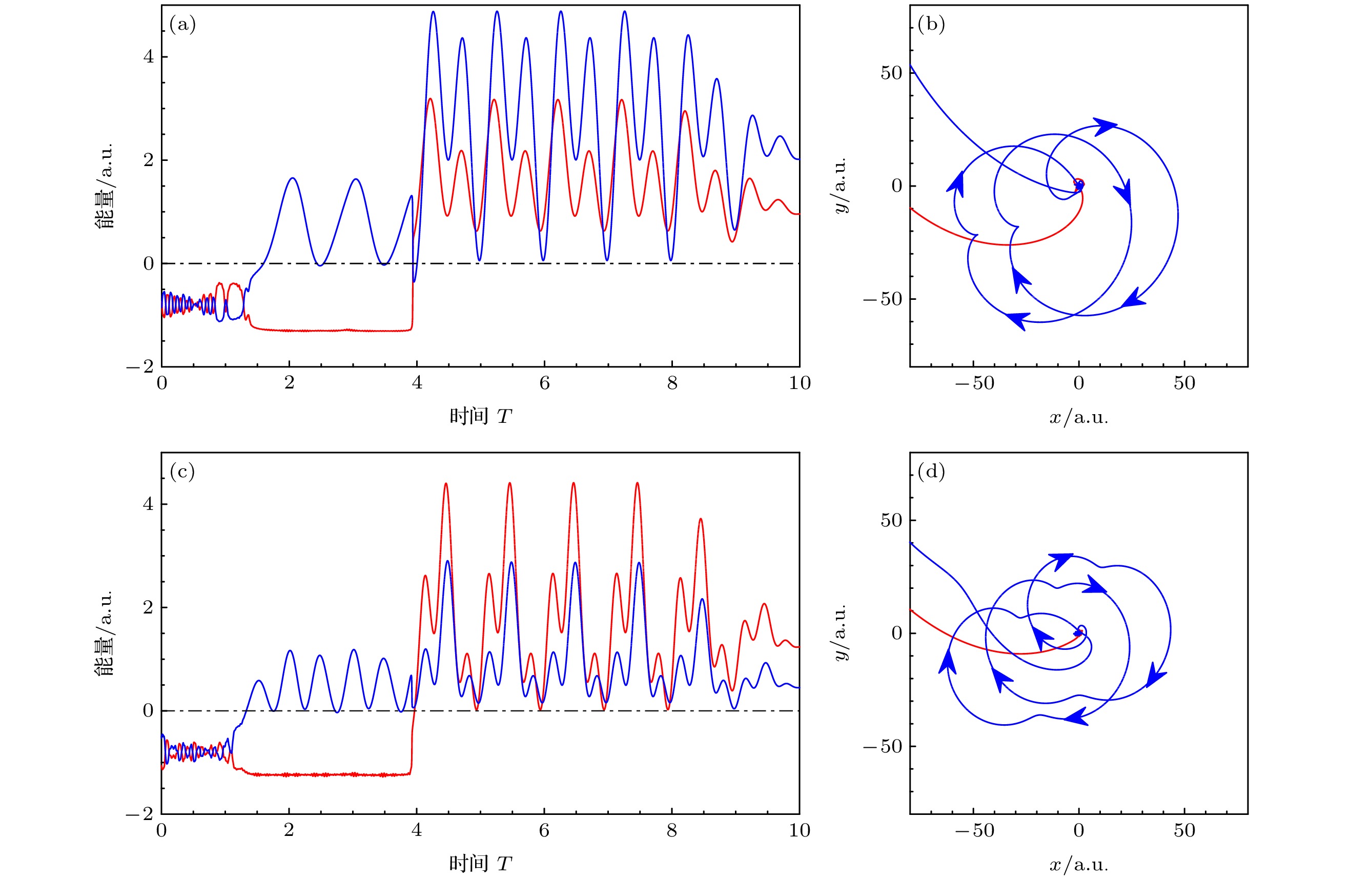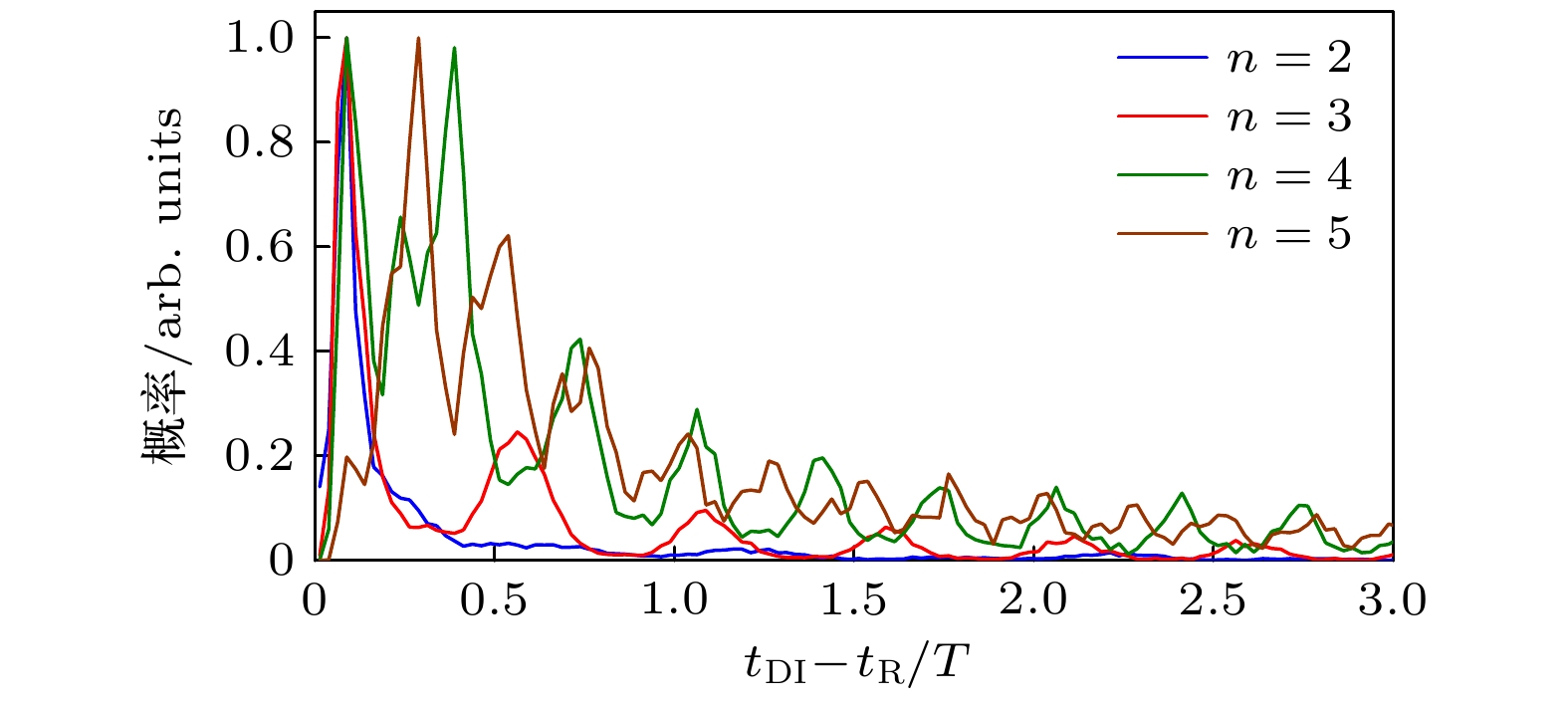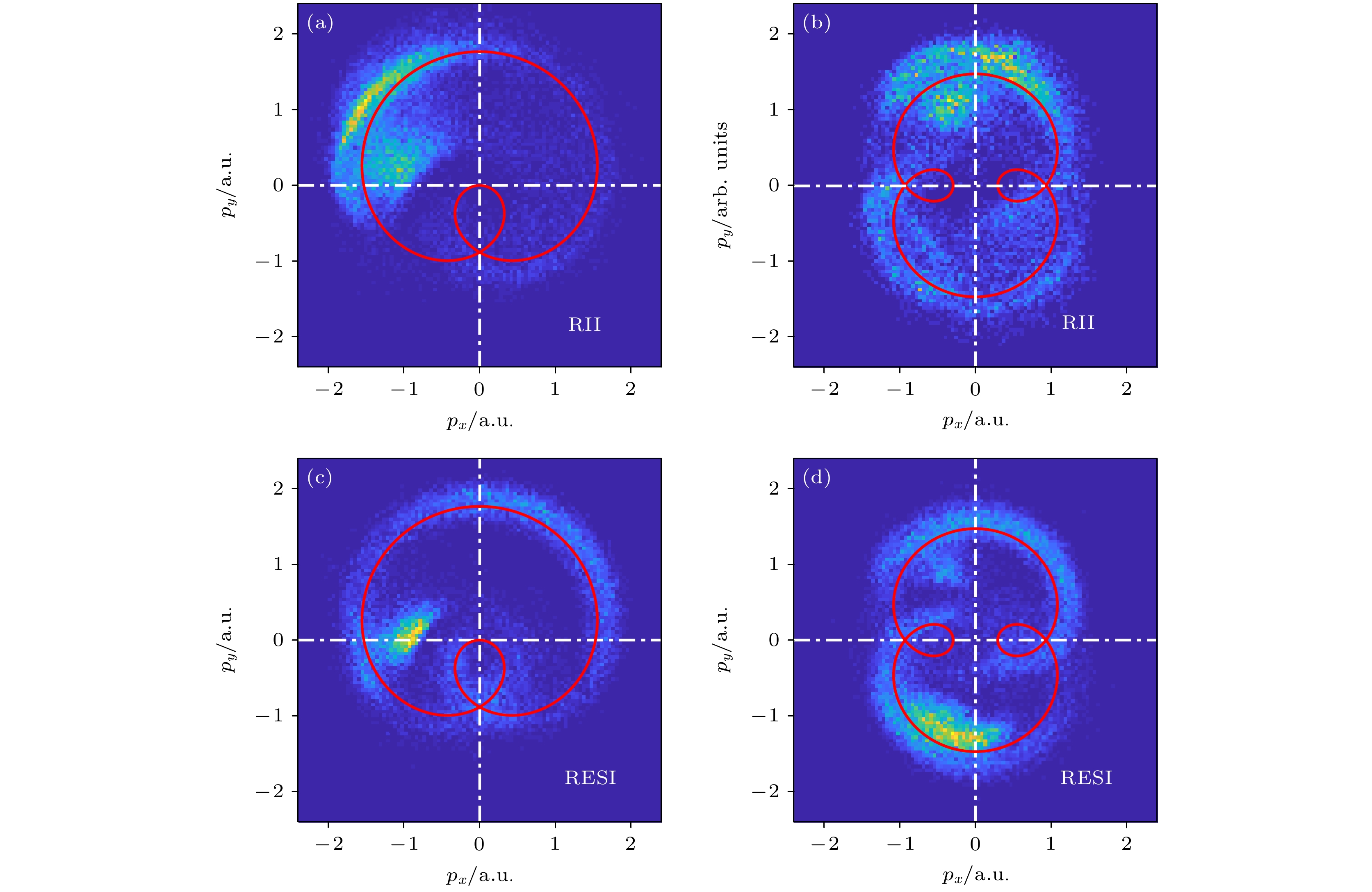-
Using a three-dimensional classical ensemble model, we investigate ultrafast dynamics in nonsequential double-ionization (NSDI) of Ar atom by co-rotating two-color circularly polarized laser fields with the frequency ratio varying between 2 and 5. Numerical results indicate that the NSDI probability gradually increases with the frequency ratio between the two components increasing. The probability for the frequency ratio 5 is one order of magnitude higher than for the frequency ratio 2. Back analysis of NSDI trajectories shows that recollision occurs mainly via a short looping trajectory. With the frequency ratio increasing, the traveling time of the free electron shortens. Furthermore, the relative contribution of recollision-induced excitation with subsequent field ionization mechanism in NSDI gradually increases as the frequency ratio increases. It is attributed to smaller recollision energy and larger recollision distance for larger frequency ratio.
[1] Corkum P B 1993 Phys. Rev. Lett. 71 1994
 Google Scholar
Google Scholar
[2] Feuerstein B, Moshammer R, Fischer D, Dorn A, Schröter C D, Deipenwisch J, Crespo Lopez-Urrutia J R, Höhr C, Neumayer P, Ullrich J, Rottke H, Trump C, Wittmann M, Korn G, Sandner W 2001 Phys. Rev. Lett. 87 043003
 Google Scholar
Google Scholar
[3] Chen Y, Zhou Y, Li Y, Li M, Lan P, Lu P 2018 Phys. Rev. A 97 013428
 Google Scholar
Google Scholar
[4] Liu Y, Fu L, Ye D, Liu J, Li M, Wu C, Gong Q, Moshammer R, Ullrich J 2014 Phys. Rev. Lett. 112 013003
 Google Scholar
Google Scholar
[5] Huang C, Guo W, Zhou Y, Wu Z 2016 Phys. Rev. A 93 013416
 Google Scholar
Google Scholar
[6] Liao Q, Winney A H, Lee S K, Lin Y F, Adhikari P, Li W 2017 Phys. Rev. A 96 023401
 Google Scholar
Google Scholar
[7] 黄诚, 钟明敏, 吴正茂 2019 物理学报 68 033201
 Google Scholar
Google Scholar
Huang C, Zhong M M, Wu Z M 2019 Acta Phys. Sin. 68 033201
 Google Scholar
Google Scholar
[8] Fittinghoff D N, Bolton P R, Chang B, Kulander K C 1992 Phys. Rev. Lett. 69 2642
 Google Scholar
Google Scholar
[9] Weber Th, Giessen H, Weckenbrock M, Urbasch G, Staudte A, Spielberger L, Jagutzki O, Mergel V, Vollmer M, Dörner R 2000 Nature 405 658
 Google Scholar
Google Scholar
[10] Wang Y, Xu S, Quan W, Gong C, Lai X, Hu S, Liu M, Chen J, Liu X 2016 Phys. Rev. A 94 053412
 Google Scholar
Google Scholar
[11] Figueira de Morisson Faria C, Liu X 2011 J. Mod. Opt. 58 1076
 Google Scholar
Google Scholar
[12] Becker W, Liu X, Jo Ho P, Eberly J H 2012 Rev. Mod. Phys. 84 1011
 Google Scholar
Google Scholar
[13] Li H Y, Chen J, Jiang H B, Liu J, Fu P M, Gong Q H, Yan Z C, Wang B B 2009 J. Phys. B 42 125601
 Google Scholar
Google Scholar
[14] Parker J S, Doherty B J S, Taylor K T, Schultz K D, Blaga C I, DiMauro L F 2006 Phys. Rev. Lett. 96 133001
 Google Scholar
Google Scholar
[15] Wang X, Eberly J H 2010 Phys. Rev. Lett. 105 083001
 Google Scholar
Google Scholar
[16] Hao X L, Chen J, Li W D, Wang B B, Wang X D, Becker W 2014 Phys. Rev. Lett. 112 073002
 Google Scholar
Google Scholar
[17] Chen Z J, Liang Y, Lin C D 2010 Phys. Rev. Lett. 104 253201
 Google Scholar
Google Scholar
[18] Ye D, Li M, Fu L, Liu J, Gong Q, Liu Y, Ullrich J 2015 Phys. Rev. Lett. 115 123001
 Google Scholar
Google Scholar
[19] 赵磊, 张琦, 董敬伟, 吕航, 徐海峰 2016 物理学报 65 223201
 Google Scholar
Google Scholar
Zhao L, Zhang Q, Dong J W, Lü H, Xu H F 2016 Acta Phys. Sin. 65 223201
 Google Scholar
Google Scholar
[20] Tan J, Xu S, Han X, Zhou Y, Li M, Cao W, Zhang Q, Lu P 2021 Adv. Photonics 3 035001
 Google Scholar
Google Scholar
[21] Zhou Y, Tan J, Li M, Lu P 2021 Sci. China, Ser. G 64 273011
 Google Scholar
Google Scholar
[22] Fleischer A, Kfir O, Diskin T, Sidorenko P, Cohen O 2014 Nat. Photonics 8 543
 Google Scholar
Google Scholar
[23] Eckart S, Kunitski M, Ivanov I, Richter M, Fehre K, Hartung A, Rist J, Henrichs K, Trabert D, Schlott N, Schmidt L P H, Jahnke T, Schoffler M S, Kheifets A, Dorner R 2018 Phys. Rev. A 97 041402
 Google Scholar
Google Scholar
[24] Li M, Jiang W, Xie H, Luo S, Zhou Y, Lu P 2018 Phys. Rev. A 97 023415
 Google Scholar
Google Scholar
[25] Ke Q, Zhou Y, Tan J, He M, Liang J, Zhao Y, Li M, Lu P 2019 Opt. Express 27 32193
 Google Scholar
Google Scholar
[26] Chaloupka J L, Hickstein D D 2016 Phys. Rev. Lett. 116 143005
 Google Scholar
Google Scholar
[27] Mancuso C A, Dorney K M, Hickstein D D, Chaloupka J L, Ellis J L, Dollar F J, Knut R, Grychtol P, Zusin D, Gentry C, Gopalakrishnan M, Kapteyn H C, Murnane M M 2016 Phys. Rev. Lett. 117 133201
 Google Scholar
Google Scholar
[28] Eckart S, Richter M, Kunitski M, Hartung A, Rist J, Henrichs K, Schlott N, Kang H, Bauer T, Sann H, Schmidt L P H, Schoffler M, Jahnke T, Dorner R 2016 Phys. Rev. Lett. 117 133202
 Google Scholar
Google Scholar
[29] Lin K, Jia X, Yu Z, He F, Ma J, Li H, Gong X, Song Q, Ji Q, Zhang W, Li H, Lu P, Zeng H, Chen J, Wu J 2017 Phys. Rev. Lett. 119 203202
 Google Scholar
Google Scholar
[30] Li B, Yang X, Ren X, Zhang J 2019 Opt. Express 27 32700
 Google Scholar
Google Scholar
[31] Xu T, Zhu Q, Chen J, Ben S, Zhang J, Liu X 2018 Opt. Express 26 1645
 Google Scholar
Google Scholar
[32] Huang C, Zhong M, Wu Z 2018 Opt. Express 26 26045
 Google Scholar
Google Scholar
[33] Ma X, Zhou Y, Chen Y, Li M, Li Y, Zhang Q, Lu P 2019 Opt. Express 27 1825
 Google Scholar
Google Scholar
[34] Huang C, Pang H, Huang X, Zhong M, Wu Z 2020 Opt. Express 28 10505
 Google Scholar
Google Scholar
[35] Pang H, Huang X, Huang C 2020 Int. J. Mod. Phys. B 34 2050304
 Google Scholar
Google Scholar
[36] Peng M, Bai L H, Guo Z 2021 Commun. Theor. Phys. 73 075501
 Google Scholar
Google Scholar
[37] Eichmann H, Egbert A, Nolte S, Momma C, Wellegehausen B 1995 Phys. Rev. A 51 R3414
 Google Scholar
Google Scholar
[38] Qiao Y, Wu D, Chen J, Wang J, Guo F, Yang Y 2019 Phys. Rev. A 100 063428
 Google Scholar
Google Scholar
[39] Huang C, Zhong M, Wu Z 2019 Opt. Express 27 7616
 Google Scholar
Google Scholar
[40] Chaloupka J L 2020 J. Phys. B 53 185601
 Google Scholar
Google Scholar
[41] Wu D, Guo F, Wang J, Chen J, Yang Y 2020 Commun. Theor. Phys. 72 055503
 Google Scholar
Google Scholar
[42] Haan S L, Breen L, Karim A, and Eberly J H 2006 Phys. Rev. Lett. 97 103008
 Google Scholar
Google Scholar
[43] Chen J, Nam C H 2002 Phys. Rev. A 66 053415
 Google Scholar
Google Scholar
[44] Li Y, Xu J, Yu B, Wang X 2020 Opt. Express 28 7341
 Google Scholar
Google Scholar
[45] Chen X, Ruiz C, He F, Zhang J 2020 Opt. Express 28 14884
 Google Scholar
Google Scholar
[46] Huang C, Zhong M, Wu Z 2018 Sci. Rep. 8 8772
 Google Scholar
Google Scholar
[47] Huang C, Zhong M, Wu Z 2016 J. Chem. Phys. 145 044302
 Google Scholar
Google Scholar
-
图 1 不同频率比时同向旋转双色场的电场矢量(蓝虚线)和负矢势(红实线) (a) 频率比为2; (b) 频率比为3; (c) 频率比为4; (d) 频率比为5. 箭头标出了时间演化的方向, 黑点标出了一个电场极大值及其对应的负矢势
Fig. 1. Combined laser electric field E(t) (dashed curves) and the corresponding negative vector potential A(t) (solid curves) for co-rotating two-color circularly polarized laser fields at different frequency ratios of (a) 2, (b) 3, (c) 4, (d) 5. The arrows indicate the time evolution direction. The black dots mark a field maximum and its negative vector potential.
-
[1] Corkum P B 1993 Phys. Rev. Lett. 71 1994
 Google Scholar
Google Scholar
[2] Feuerstein B, Moshammer R, Fischer D, Dorn A, Schröter C D, Deipenwisch J, Crespo Lopez-Urrutia J R, Höhr C, Neumayer P, Ullrich J, Rottke H, Trump C, Wittmann M, Korn G, Sandner W 2001 Phys. Rev. Lett. 87 043003
 Google Scholar
Google Scholar
[3] Chen Y, Zhou Y, Li Y, Li M, Lan P, Lu P 2018 Phys. Rev. A 97 013428
 Google Scholar
Google Scholar
[4] Liu Y, Fu L, Ye D, Liu J, Li M, Wu C, Gong Q, Moshammer R, Ullrich J 2014 Phys. Rev. Lett. 112 013003
 Google Scholar
Google Scholar
[5] Huang C, Guo W, Zhou Y, Wu Z 2016 Phys. Rev. A 93 013416
 Google Scholar
Google Scholar
[6] Liao Q, Winney A H, Lee S K, Lin Y F, Adhikari P, Li W 2017 Phys. Rev. A 96 023401
 Google Scholar
Google Scholar
[7] 黄诚, 钟明敏, 吴正茂 2019 物理学报 68 033201
 Google Scholar
Google Scholar
Huang C, Zhong M M, Wu Z M 2019 Acta Phys. Sin. 68 033201
 Google Scholar
Google Scholar
[8] Fittinghoff D N, Bolton P R, Chang B, Kulander K C 1992 Phys. Rev. Lett. 69 2642
 Google Scholar
Google Scholar
[9] Weber Th, Giessen H, Weckenbrock M, Urbasch G, Staudte A, Spielberger L, Jagutzki O, Mergel V, Vollmer M, Dörner R 2000 Nature 405 658
 Google Scholar
Google Scholar
[10] Wang Y, Xu S, Quan W, Gong C, Lai X, Hu S, Liu M, Chen J, Liu X 2016 Phys. Rev. A 94 053412
 Google Scholar
Google Scholar
[11] Figueira de Morisson Faria C, Liu X 2011 J. Mod. Opt. 58 1076
 Google Scholar
Google Scholar
[12] Becker W, Liu X, Jo Ho P, Eberly J H 2012 Rev. Mod. Phys. 84 1011
 Google Scholar
Google Scholar
[13] Li H Y, Chen J, Jiang H B, Liu J, Fu P M, Gong Q H, Yan Z C, Wang B B 2009 J. Phys. B 42 125601
 Google Scholar
Google Scholar
[14] Parker J S, Doherty B J S, Taylor K T, Schultz K D, Blaga C I, DiMauro L F 2006 Phys. Rev. Lett. 96 133001
 Google Scholar
Google Scholar
[15] Wang X, Eberly J H 2010 Phys. Rev. Lett. 105 083001
 Google Scholar
Google Scholar
[16] Hao X L, Chen J, Li W D, Wang B B, Wang X D, Becker W 2014 Phys. Rev. Lett. 112 073002
 Google Scholar
Google Scholar
[17] Chen Z J, Liang Y, Lin C D 2010 Phys. Rev. Lett. 104 253201
 Google Scholar
Google Scholar
[18] Ye D, Li M, Fu L, Liu J, Gong Q, Liu Y, Ullrich J 2015 Phys. Rev. Lett. 115 123001
 Google Scholar
Google Scholar
[19] 赵磊, 张琦, 董敬伟, 吕航, 徐海峰 2016 物理学报 65 223201
 Google Scholar
Google Scholar
Zhao L, Zhang Q, Dong J W, Lü H, Xu H F 2016 Acta Phys. Sin. 65 223201
 Google Scholar
Google Scholar
[20] Tan J, Xu S, Han X, Zhou Y, Li M, Cao W, Zhang Q, Lu P 2021 Adv. Photonics 3 035001
 Google Scholar
Google Scholar
[21] Zhou Y, Tan J, Li M, Lu P 2021 Sci. China, Ser. G 64 273011
 Google Scholar
Google Scholar
[22] Fleischer A, Kfir O, Diskin T, Sidorenko P, Cohen O 2014 Nat. Photonics 8 543
 Google Scholar
Google Scholar
[23] Eckart S, Kunitski M, Ivanov I, Richter M, Fehre K, Hartung A, Rist J, Henrichs K, Trabert D, Schlott N, Schmidt L P H, Jahnke T, Schoffler M S, Kheifets A, Dorner R 2018 Phys. Rev. A 97 041402
 Google Scholar
Google Scholar
[24] Li M, Jiang W, Xie H, Luo S, Zhou Y, Lu P 2018 Phys. Rev. A 97 023415
 Google Scholar
Google Scholar
[25] Ke Q, Zhou Y, Tan J, He M, Liang J, Zhao Y, Li M, Lu P 2019 Opt. Express 27 32193
 Google Scholar
Google Scholar
[26] Chaloupka J L, Hickstein D D 2016 Phys. Rev. Lett. 116 143005
 Google Scholar
Google Scholar
[27] Mancuso C A, Dorney K M, Hickstein D D, Chaloupka J L, Ellis J L, Dollar F J, Knut R, Grychtol P, Zusin D, Gentry C, Gopalakrishnan M, Kapteyn H C, Murnane M M 2016 Phys. Rev. Lett. 117 133201
 Google Scholar
Google Scholar
[28] Eckart S, Richter M, Kunitski M, Hartung A, Rist J, Henrichs K, Schlott N, Kang H, Bauer T, Sann H, Schmidt L P H, Schoffler M, Jahnke T, Dorner R 2016 Phys. Rev. Lett. 117 133202
 Google Scholar
Google Scholar
[29] Lin K, Jia X, Yu Z, He F, Ma J, Li H, Gong X, Song Q, Ji Q, Zhang W, Li H, Lu P, Zeng H, Chen J, Wu J 2017 Phys. Rev. Lett. 119 203202
 Google Scholar
Google Scholar
[30] Li B, Yang X, Ren X, Zhang J 2019 Opt. Express 27 32700
 Google Scholar
Google Scholar
[31] Xu T, Zhu Q, Chen J, Ben S, Zhang J, Liu X 2018 Opt. Express 26 1645
 Google Scholar
Google Scholar
[32] Huang C, Zhong M, Wu Z 2018 Opt. Express 26 26045
 Google Scholar
Google Scholar
[33] Ma X, Zhou Y, Chen Y, Li M, Li Y, Zhang Q, Lu P 2019 Opt. Express 27 1825
 Google Scholar
Google Scholar
[34] Huang C, Pang H, Huang X, Zhong M, Wu Z 2020 Opt. Express 28 10505
 Google Scholar
Google Scholar
[35] Pang H, Huang X, Huang C 2020 Int. J. Mod. Phys. B 34 2050304
 Google Scholar
Google Scholar
[36] Peng M, Bai L H, Guo Z 2021 Commun. Theor. Phys. 73 075501
 Google Scholar
Google Scholar
[37] Eichmann H, Egbert A, Nolte S, Momma C, Wellegehausen B 1995 Phys. Rev. A 51 R3414
 Google Scholar
Google Scholar
[38] Qiao Y, Wu D, Chen J, Wang J, Guo F, Yang Y 2019 Phys. Rev. A 100 063428
 Google Scholar
Google Scholar
[39] Huang C, Zhong M, Wu Z 2019 Opt. Express 27 7616
 Google Scholar
Google Scholar
[40] Chaloupka J L 2020 J. Phys. B 53 185601
 Google Scholar
Google Scholar
[41] Wu D, Guo F, Wang J, Chen J, Yang Y 2020 Commun. Theor. Phys. 72 055503
 Google Scholar
Google Scholar
[42] Haan S L, Breen L, Karim A, and Eberly J H 2006 Phys. Rev. Lett. 97 103008
 Google Scholar
Google Scholar
[43] Chen J, Nam C H 2002 Phys. Rev. A 66 053415
 Google Scholar
Google Scholar
[44] Li Y, Xu J, Yu B, Wang X 2020 Opt. Express 28 7341
 Google Scholar
Google Scholar
[45] Chen X, Ruiz C, He F, Zhang J 2020 Opt. Express 28 14884
 Google Scholar
Google Scholar
[46] Huang C, Zhong M, Wu Z 2018 Sci. Rep. 8 8772
 Google Scholar
Google Scholar
[47] Huang C, Zhong M, Wu Z 2016 J. Chem. Phys. 145 044302
 Google Scholar
Google Scholar
计量
- 文章访问数: 6310
- PDF下载量: 72
- 被引次数: 0













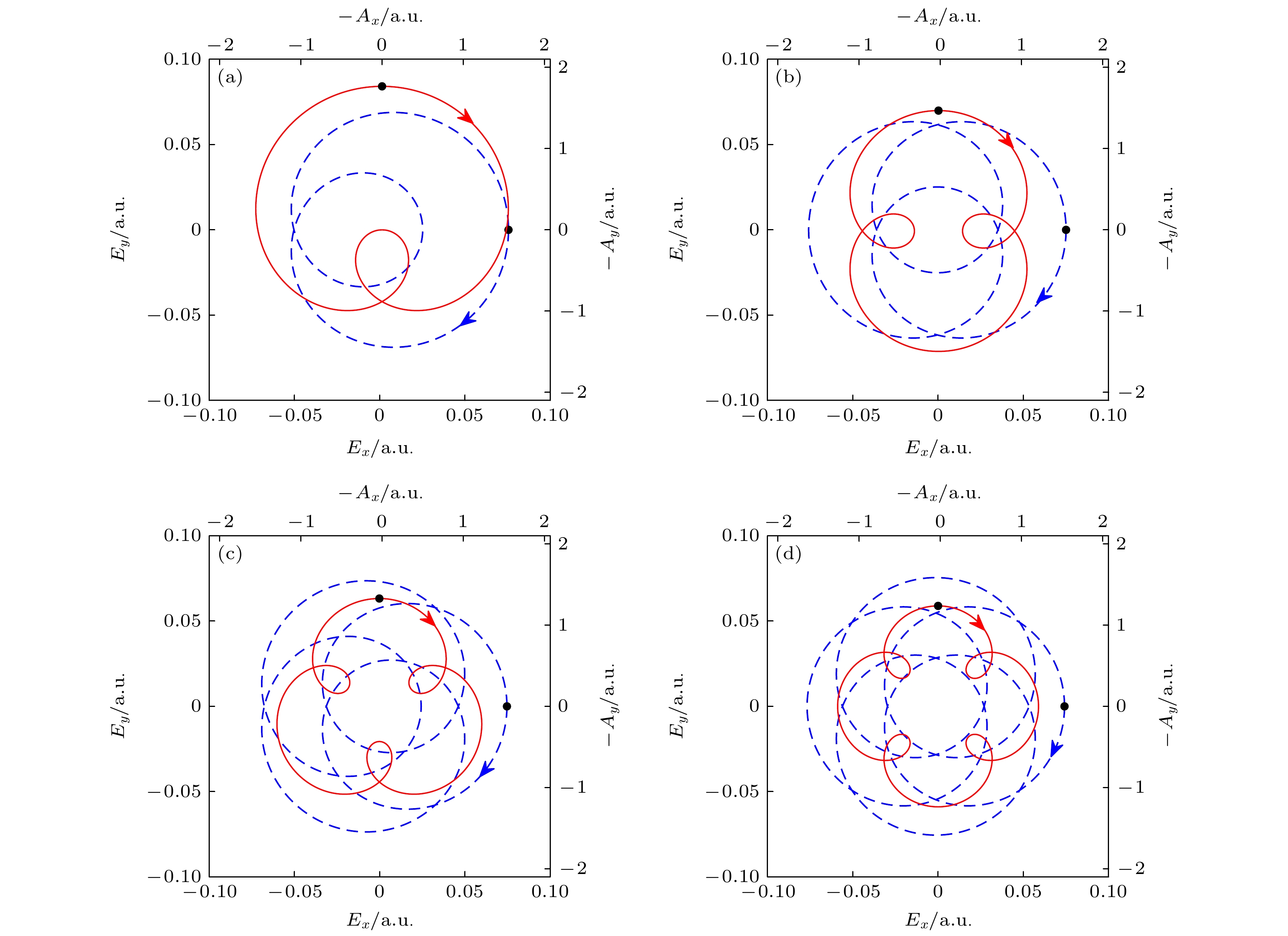
 下载:
下载:
